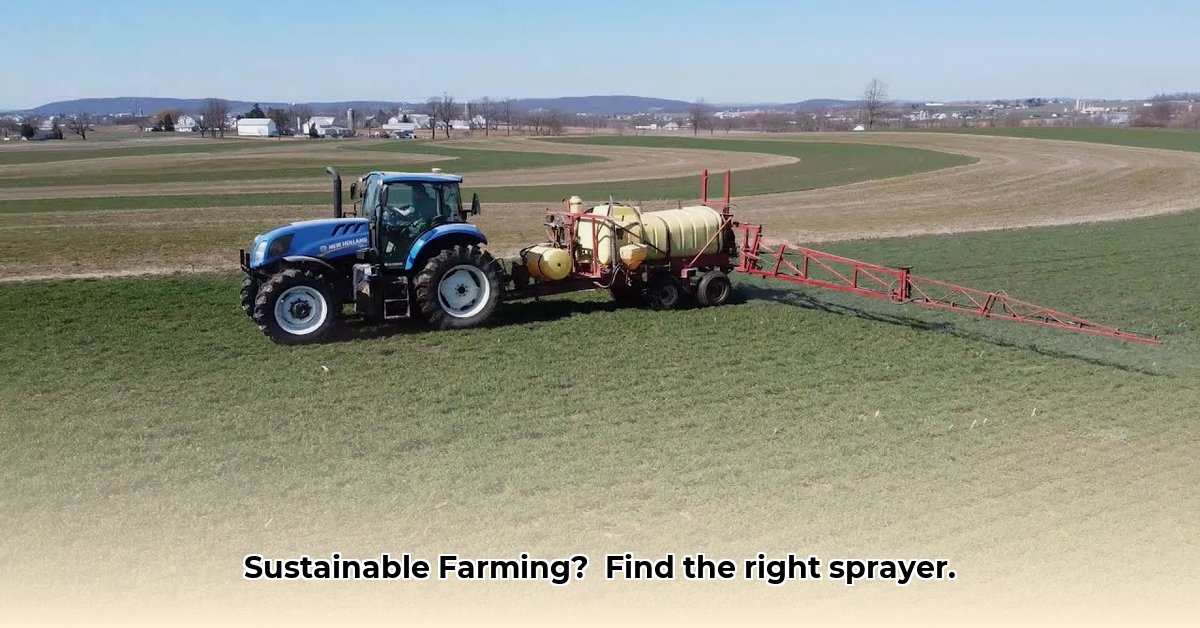
Choosing the right fertilizer sprayer tractor is crucial for efficient and sustainable farming. Whether you manage a small backyard garden or a vast expanse of farmland, selecting the appropriate equipment ensures optimal fertilizer application, minimizing waste and maximizing yields. This guide will walk you through the process, helping you choose a sprayer that perfectly fits your needs and contributes to a healthier environment. For more on tractor types, check out this helpful guide on tractor types.
Understanding Your Farming Operation
Before exploring different sprayer types, it's vital to assess your specific farming needs. Consider these key factors:
Farm Size: The size of your operation directly impacts the required sprayer capacity. A small backyard garden might only need a handheld sprayer, while large-scale farming demands a powerful, self-propelled machine. Consider the total acreage you need to cover, and whether your fields have challenging terrain.
Crop Types: Different crops have varying fertilizer requirements and application methods. The height, density, and spacing of your crops will influence the type of sprayer suitable for your operation. For example, tall, dense crops necessitate a sprayer with adjustable boom height.
Budget: Fertilizer sprayers range widely in price, from affordable handheld models to high-tech, automated systems. Establish a realistic budget, including not only the initial cost but also ongoing maintenance expenses.
Automation Needs: Your comfort level with technology and desired level of automation will influence your decision. Handheld sprayers require minimal mechanical knowledge, while self-propelled sprayers offer advanced features like GPS guidance and variable-rate application but necessitate greater mechanical expertise.
Exploring Your Fertilizer Sprayer Options
Several sprayer types cater to various farming operations:
Handheld Sprayers: Ideal for small gardens and precise spot treatment, these lightweight and affordable options are easy to handle and maintain. They are best suited for small-scale gardening and localized applications.
Backpack Sprayers: Offering increased capacity compared to handheld sprayers, backpack sprayers are suitable for larger gardens or smaller plots. They provide greater maneuverability than larger options but still require manual operation.
Tow-Behind Sprayers: These attach to a tractor, significantly improving coverage area and efficiency. They are a cost-effective solution for medium-sized farms requiring greater capacity than handheld or backpack sprayers. However, they still require a tractor for operation.
Self-Propelled Sprayers: These large, highly automated machines are designed for large-scale farming operations. They boast high capacity and advanced features such as GPS guidance and variable rate application, maximizing efficiency. These, however, present a higher initial investment and increased maintenance complexity.
Deciding on the Right Fit: A Practical Guide
This table summarizes the suitability of different sprayer types based on your operation's scale:
| Factor | Small-Scale (<5 acres) | Medium-Scale (5-50 acres) | Large-Scale (>50 acres) |
|---|---|---|---|
| Suitable Sprayer | Handheld, Backpack | Tow-Behind, Small Self-Propelled | Self-Propelled |
| Capacity (gallons) | 1-5 | 5-100 | 100+ |
| Automation | Manual | Partial Automation | Advanced Automation |
| Typical Cost | Low | Medium | High |
Safe and Effective Fertilizer Application: A Step-by-Step Guide
Safety is paramount. Always adhere to the manufacturer's instructions for your specific sprayer model; this section provides a general guideline.
Pre-Spray Inspection: Thoroughly inspect your sprayer for leaks, worn parts, or damage before each use.
Fertilizer Mixing and Loading: Carefully follow fertilizer label instructions for mixing ratios to ensure optimal effectiveness and avoid potential crop damage. Load the mixed fertilizer into the tank, preventing spills.
Calibration: Accurate calibration is crucial for efficient fertilizer application. Consult your sprayer's manual for precise calibration instructions. Incorrect calibration leads to fertilizer waste and environmental impact.
Personal Protective Equipment (PPE): Always wear appropriate safety gear, including gloves, goggles, a face mask, and protective clothing. Exposure to fertilizers can be harmful.
Safe Operation: Operate the sprayer according to safety regulations. Be mindful of wind conditions to minimize drift, and ensure you have sufficient training if using complex machinery.
Clean-Up: After each use, thoroughly clean the sprayer to prevent corrosion, ensure its longevity, and prevent contamination.
Sustainable Considerations: Minimizing Environmental Impact
Sustainable farming practices minimize environmental impact:
Minimize Drift: Employ low-drift nozzles to reduce fertilizer loss and minimize environmental contamination.
Targeted Application: Precision application techniques, like GPS-guided spraying, maximize fertilizer efficiency and reduce waste.
Sustainable Materials: Choose sprayers made from recycled or sustainably sourced materials whenever possible.
Maintaining Your Investment
Regular maintenance extends sprayer lifespan and prevents costly repairs. This includes thorough cleaning after each use, proper storage to prevent corrosion, and regular checks for wear and tear. Preventative maintenance significantly impacts equipment longevity and operational efficiency.
Conclusion: Choosing Wisely for a Sustainable Future
Selecting the right fertilizer sprayer tractor requires careful consideration based on the scale of your operation, budget, and commitment to sustainable practices. This guide helps you navigate the various options and implement efficient, environmentally responsible fertilization strategies. By making informed decisions today, you are investing in a sustainable and successful farming future.